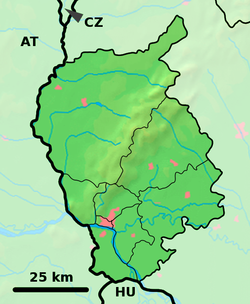Ethnicity
Census 2021 (1+ %) [12] [13] | Ethnicity | Number | Fraction |
|---|
| Slovak | 11,426 | 90.71% |
| Not found out | 918 | 7.28% |
| Czech | 170 | 1.34% |
| Total | 12,595 |
In year 2021 was 12,595 people by ethnicity 11,426 as Slovak, 918 as Not found out, 170 as Czech, 100 as Hungarian, 83 as Other, 58 as Rusyn, 38 as German, 30 as Ukrainian, 22 as Russian, 15 as Polish, 13 as Serbian, 10 as Croatian, 9 as Italian, 9 as Romanian, 8 as French, 8 as English, 8 as Albanian, 7 as Romani, 6 as Iranian, 5 as Austrian, 5 as Moravian, 4 as Chinese, 4 as Irish, 3 as Jewish, 2 as Turkish, 1 as Korean, 1 as Canadian, 1 as Greek and 1 as Bulgarian.
| Note on population |
|---|
The difference between the population numbers above and in the census (here and below) is that the population numbers above are mostly made up of permanent residents, etc.; and the census should indicate the place where people actually mainly live.
For example, a student is a citizen of a village because he has permanent residence there (he lived there as a child and has parents), but most of the time he studies at a university in the city. |
Religion
In year 2021 was 12,595 people by religion 6032 from Roman Catholic Church, 4811 from None, 894 from Not found out, 286 from Evangelical Church, 161 from Greek Catholic Church, 53 from Eastern Orthodox Church, 51 from Other, 49 from Ad hoc movements, 43 from Christian Congregations in Slovakia, 42 from Calvinist Church, 31 from Buddhism, 20 from Other and not ascertained christian church, 19 from Jehovah's Witnesses, 18 from Bahá'i Community, 16 from Paganism and natural spirituality, 14 from Church of the Brethren, 12 from Islam, 8 from Jewish community, 6 from Baptists Church, 6 from Apostolic Church, 5 from United Methodist Church, 5 from Czechoslovak Hussite Church, 4 from Hinduism, 3 from Seventh-day Adventist Church, 3 from Church of Jesus Christ of Latter-day Saints, 2 from Old Catholic Church and 1 from New Apostolic Church.




